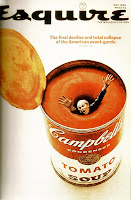Advertising in the 1960's revolved around politics, culture, and technology. But that was the 60's: a time of protest, of free-thinking, the British Invasion, and movements for the rights of Americans. The advertising world revolved around what was going on in America and the demands of it's citizens.
New York City was the golden place of advertising. Agencies successful during the decade included McCann-Erickson; J. Walter Thompson; Batten, Burton, Durstine, and Osborne; Young and Rubican; Leo Burnett; Ogilvy and Mather; and Doyle Dane Bernbach.
In
Advertising in the 60's: Turncoats, Traitionalists, and Waste Makers in America's Turbulent Decade by Hazel G. Warlaumont, she includes a chronological chart with popular brands that appeared during the decade:
1960 Domino's Pizza delivers hot, fresh pies in Ann Arbor, Michigan.
1960 Etch A Sketch magnetic screen makes artists out of children and adults.
1962 Royal Crown Diet Cola is the first nationally marketed low-calorie soft drink, quickly followed by Coca Cola's Tab and Pepsi's Patio Cola.
1963 The Corvette Sting Ray is one of the hottest cars on the road.
1963 Weight Watcher's is founded by Jean Nidetch to help people take off pounds sensibly.
1964 Gatorade sports drink first appears on the sidelines at University of Florida Gators' football games.
1964 The Ford Mustang is introduced as a sporty, stylish car priced at just $2,368.
1968 The Big Mac appears on McDonald's fast food menu, featuring "two all beef patties special sauce lettuce cheese pickles onions on a sesame seed bun."
There was also legislation that affected advertising at the time, including the 1963 Equal Pay Act which stated that men and women in the same job should be paid equally, the 1965 Highway Beautification Act which prohibited commercial signs within 660 feet of federally funded highways, and the 1968 Equal Oppurtunity Opportunity Commision which factored in race to job employment.




























